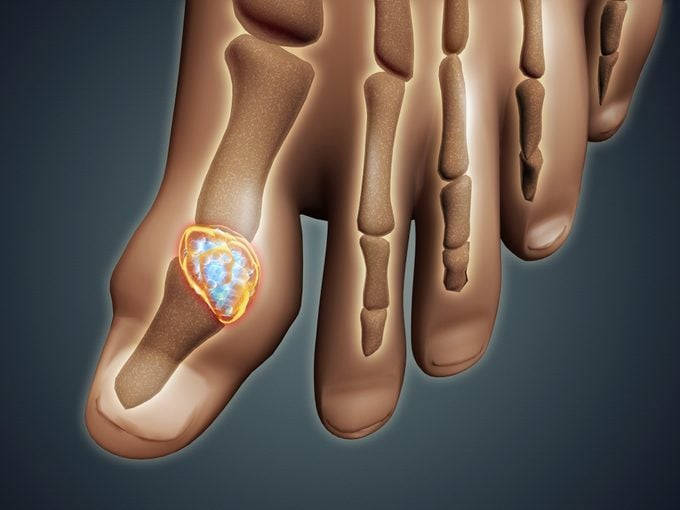7 Foods (And Drinks) to Avoid With Gout
Updated: Sep. 27, 2021
If you've ever suffered from an excruciating gout attack, you never want to experience another one. Certain foods can trigger a flare. Here are the foods to avoid if you have gout.
Our editors and experts handpick every product we feature. We may earn a commission from your purchases.
What is gout?
Gout is a type of inflammatory arthritis caused by a buildup of excess uric acid in the body. Either the body makes too much uric acid, or the kidneys may not get rid of enough uric acid.
When the uric acid breaks down, tiny, painful, needle-like crystals form and move into just about any joint, including the ankle, hand, or knee, but the most common target is the big toe.
Gout attacks (also known as flares) typically happen at night with no warning, causing pain so intense you may not be able to move the affected joint for hours. Medications and even essential oils can help bring faster relief during a gout flare.
Avoiding certain foods that cause elevated uric acid levels, however, might ward off a gout attack altogether. Learn the foods to avoid with gout and how they could affect your overall health.

There’s more to gout than too much uric acid
Before we dive into the list of foods to avoid with gout, it’s important to get to the root of what causes too much uric acid and who is at a higher risk.
First, no one is exempt from getting gout. Some people are just more sensitive to purine-rich foods and drinks and thus churn out more uric acid. Genes can play a significant role, so if you have a relative with gout, you might be at a higher risk.
Second, putting on weight through adulthood is associated with a higher risk of gout, according to research published in 2021 in the journal Arthritis Research and Therapy.
In an earlier study published in Arthritis and Rheumatology, overweight people were 85 percent more likely to have higher uric acid levels than people at a healthy weight.
Foods to avoid with gout
When a patient asks Bernadette Siaton MD, a rheumatologist at the University of Maryland Medical Center who treats gout, what foods they should avoid, she doesn’t recommend specific foods.
Instead, she encourages her patients to eat a low-fat, low-sugar, healthy and balanced diet.
“That type of diet is beneficial for most people, even in the absence of gout,” Dr. Siaton says.
Weight loss is recommended for people with gout who are overweight or obese, even if gout flares are rare or nonexistent, according to the 2020 American College of Rheumatology Guidelines for the Management of Gout.
Still, gout is a disease that results from excess uric acid burden in the body.
“Some foods have high purine content, and when the body breaks down purines, uric acid is the end result,” Dr. Siaton says. “I tell patients to stay away from foods high in purines.”
With that said, here are some foods and drinks you generally should avoid to keep gout at bay.
Certain meats and seafood
Not all sources of purine are equal when managing gout, and research suggests certain purines can make gout worse.
“Studies show that hypoxanthine purines, found in meat and fish, have a stronger effect on on purine production compared to other types of purine,” says Nichole Dandrea MS, RDN, and author of The Fiber Effect: Stop Counting Calories and Start Counting Fiber For Better Health, referencing research in the BMJ.
Yet not all meats and seafood are off-limits. Some are just worse for gout symptoms than others.
Dr. Siaton recommends people with gout pass on red meats such as lamb, beef, and pork. Organ and glandular meats such as liver, tripe, and sweetbread have high purine content, too.
As for seafood, trout, haddock, codfish, anchovies, sardines, herring, mussels, and scallops are higher-purine options to avoid.
You might be able to tolerate moderately high-purine seafood such as crab, lobster, oysters, and shrimp. But make sure to limit consumption.
(If a gout flare strikes, these gout natural remedies could help ease your pain and symptoms.)
Sugary drinks

In addition to the foods to avoid with gout, there are beverages to cut out or limit, too. High-fructose corn syrup beverages prompt an uptick in uric acid production because high-fructose corn syrup metabolizes differently from glucose.
Within minutes of drinking this sugary concoction, the body releases purines, producing uric acid. Sugary drinks are associated with obesity, which is also linked to gout. And some individuals with gout often have diabetes and other co-morbidities.
The American College of Rheumatology recommends limiting high fructose corn syrup for patients with gout regardless of disease activity.
“This recommendation is included to promote water intake and reduce added sugar intake for individuals rather than a direct impact on gout flare-ups,” says registered dietitian nutritionist Julie Stefanski, MEd, a national spokesperson for the Academy of Nutrition and Dietetics.
Alcohol
We’ve all heard the health advice that one drink a day for women and two drinks for men is generally safe. But if you have gout, that might not apply to you.
The truth is wine, liquor, and beer, even in moderate amounts, increase the risk of recurrent gout attacks. Just one to two drinks are associated with a 40 percent higher risk of a gout flare-up within 24 hours of consumption versus drinking no alcohol.
You should especially steer clear of beer if you have gout. “Beer is worse than other kinds of alcohol because of its high purine content,” Dr. Siaton says.
All alcohol contains ethanal, which can increase uric acid, but beer also contains high levels of guanosine, a purine that is highly absorbable.
This means uric acid stays in the body instead of exiting out via urine production, which could mean a painful gout flare-up on the horizon.
(Need to cut back? Here are 17 simple tips for limiting alcohol.)
Soups, broths, and gravies
Meat-based soups, broths, and gravies could be a double-whammy for people with gout, Stefanski says. That’s due to their high sodium content and purines.
These types of foods might not be totally off-limits, however. Instead, swap meat-heavy soup and broth for veggie-heavy options. A hearty lentil soup with antioxidant-rich veggies is lower in purines and can help lower inflammation.
But what about that Thanksgiving gravy? Try this delicious mushroom-based gravy to pour over your mashed potatoes.
Contrary to popular belief, mushrooms (as well as veggies with purine) are actually OK to eat if you have gout. Keep reading to find out why.
Why are purine-rich veggies OK in a gout diet?
Mushrooms and some vegetables like spinach and asparagus were once considered off-limits for people with gout, but not anymore.
“It used to be thought that any type of purine can increase the synthesis or uric acid, however research shows that the type of purine matters,” Dandrea says.
We know the purine hypoxanthine (found in meat) increases uric acid production, but the purines adenine and guanine (found in vegetables) don’t carry the same punch.
In reality, veggies inhibit uric acid synthesis, Dandrea says, citing research published in the Journal of Advanced Research.
Even better, various studies suggest high-purine plant foods, in comparison with high-purine animal foods, are not associated with elevated levels of uric acid or gout development.
“In fact, plant-based diets have been shown to decrease gout development and the co-morbidities associated with gout, such as cardiovascular disease, diabetes, and hypertension,” Dandrea says.
The bottom line
It’s important to note that foods with purine can affect people differently.
“It may not be necessary to completely avoid a food if it’s not a personal trigger,” Stefanski says.
On the other hand, some people may be more sensitive to certain purine-rich foods, setting off a gout flare.
“It’s important to try to pay attention to what may have been a trigger for your last gout flare,” Stefanski says. When you identify the culprit, avoid that food.
Uric acids levels get all the attention, but the pain related to gout crystals involves inflammation, too.
“The focus should be on including certain types of foods that help our bodies to calm inflammatory process,” Stefanski says. “While we don’t fully understand how to control inflammation, getting lots of antioxidants from vegetables and fruits, plenty of water, and the right types of fats are important.”
And simply swapping out some meat-based meals for plant-based meals throughout the week can be effective for gout management, Dandrea adds.
Now that you know the foods to avoid with gout, check out these arthritis facts.



















